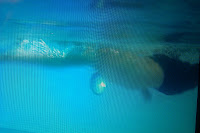The following videos show an expert and a novice executing the freestyle swimming position.
Due to camera angles, poor equipment and excessive instability of hand recorded videos the following animation is provided below. This animation is perhaps the best representation for the proper execution of the freestyle stroke due to its stability and ability to provide all aspects of movement clearly.
Phases of Freestyle Swimming
Upper Body-
1. Entry Phase
During the entry phase you want to begin by flexing the elbow, the elbow should be superior to the hand during this phase. The hand should be anterior to the shoulder with the fingers adducted completely. The fingertips should enter first with the thumb down and arm internally rotated. The arm should slide anteriorly and slightly inferior until it reaches maximum extension in front of you.
2. Catch Phase
The catch phase begins as soon as the arm is fully extended during the entry phase. During the catch phase the elbow has to flex and the shoulder must internally rotate in order for the fingers to point down towards the bottom of the pool. At this point the hand is used to begin propelling the body forward. Abducting the fingers does not allow for proper "catching" of the water.
3. Pull Phase
The pull phase begins usually half way through the catch phase and from this phase the swimmer can gain a lot of speed. During the pull the hand, forearm and arm pull the water caught during the catch phrase and move posteriorly past the shoulder. During this phase the elbow remain flexed until it passes the shoulder and then it moves onto the next phase.
4. Follow-through Phase
The follow through phase begins as soon as the flexed elbow passes the shoulder during the pull phase. Once the elbow moves posteriorly past the shoulder, the arm elbow begins to extend until it it parallel to the thigh. At the end of this phase the arm should be fully extended to the side of the swimmer
5. Recovery Phase
The recovery phase begins as soon as the arm is completely extended to the swimmers side. The swimmer must hyperextend the shoulder at the glenohumeral joint and slightly externally rotate in order to allow arm to position itself to exit the water. Once the arm externally rotates you want to let momentum guide your arm out of the water where you will flex at the elbow again to begin the entry phase.
Lower Body-
1. Hip Movement
Many swimmers flex their tibio-femoral joint along the too much while kicking this is considered kicking from the knee. This creates large amounts of drag and causes swimmer's legs to sink low in the water. Instead of kicking from the knee you should kick from the hip with a relatively extended leg. You should keep your legs extended and move them simultaneously up and down. It is best not to think about flexing your knee at all, instead think about kicking from the hip at the iliofemoral joint with an extended leg and a very slight flexion of the knee will happen naturally.
2. Foot Movement
When you swim you should always have your ankle plantar flexed. Not pointing your toes down and keeping the ankle in dorsi-flexion will push water anteriorly when you kick, slowing your velocity dramatically.
Common Mistakes:
Dropping the elbow, abducting the hands allowing water to seep through, not moving the legs, excessive dorsiflexion of the ankle, not properly breathing.
Cue:
Always keep the elbows high and keep coordination between upper and lower body.
Catch-Up Drill:
This drill is good for freestyle because it emphasizes a power feeling in the last third of the stroke.
• With both arms extended above the head, pull with one hand, recover to the beginning (both arm
extended forward) and touch the other hand. Focus on locking your elbow straight when you
extend your arm to touch the other hand.
• Repeat the motion with the other hand.











